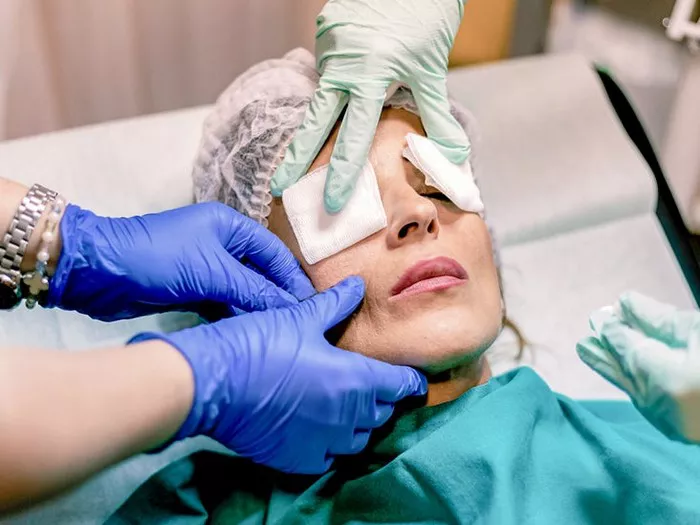In the realm of cosmetic surgery, procedures aimed at rejuvenating the eyes have gained immense popularity. One such procedure that has been the focus of attention is eye lift surgery, medically known as blepharoplasty. This surgical technique is designed to address a range of aesthetic concerns around the eyes, helping individuals achieve a more youthful and refreshed appearance. In this comprehensive guide, we will explore what eye lift surgery entails, the various types of blepharoplasty, who might benefit from it, and what to expect during the procedure.
Understanding Eye Lift Surgery (Blepharoplasty)
Eye lift surgery, or blepharoplasty, is a surgical procedure that focuses on rejuvenating the appearance of the eyes by addressing issues such as sagging eyelids, excess skin, and puffiness. The goal is to create a more youthful, alert, and refreshed look.
Key Aspects of Eye Lift Surgery
Upper Blepharoplasty: This procedure is targeted at the upper eyelids and involves the removal of excess skin, muscle, and fat. It is commonly performed to address drooping upper eyelids that can impair vision and create a tired appearance.
Lower Blepharoplasty: Lower eyelid surgery is aimed at addressing issues such as under-eye bags, puffiness, and excess skin. Surgeons may remove or reposition fat deposits and tighten the skin to achieve a smoother lower eyelid contour.
Transconjunctival Blepharoplasty: A specialized form of lower eyelid surgery, transconjunctival blepharoplasty involves making incisions on the inner side of the lower eyelid, eliminating visible external scarring. This technique is often chosen when fat repositioning or removal is required.
Canthoplasty: Canthoplasty is a procedure that can be combined with blepharoplasty to adjust the position of the outer corner of the eye. It can help improve the shape and appearance of the eyes.
Who Is a Candidate for Eye Lift Surgery?
Eye lift surgery is suitable for individuals who have specific concerns related to the appearance of their eyelids and meet certain criteria. Ideal candidates typically exhibit the following characteristics:
Excess Skin: Candidates may have sagging or excess skin on the upper or lower eyelids, which can impair vision or create a tired look.
Under-Eye Puffiness: Puffiness or bags under the eyes, often caused by fat deposits, can be effectively addressed with lower blepharoplasty.
Realistic Expectations: Candidates should have realistic expectations about the outcomes of the procedure. It is important to understand that while eye lift surgery can rejuvenate the eyes, it may not completely erase all signs of aging.
Good General Health: Candidates should be in good overall health, and any underlying medical conditions should be well-managed.
Non-Smokers: Smoking can impede the healing process and increase the risk of complications. Candidates are typically advised to quit smoking before the procedure.
What to Expect During Eye Lift Surgery
Consultation: The journey begins with a consultation with a board-certified plastic surgeon or oculoplastic surgeon. During this appointment, you will discuss your goals, concerns, and medical history. The surgeon will assess your eyelids and recommend a tailored treatment plan.
Anesthesia: Eye lift surgery can be performed under local anesthesia with sedation or general anesthesia, depending on the surgeon’s recommendation and patient preferences. Anesthesia is administered by trained professionals to ensure comfort and safety.
Surgical Technique: The surgical technique employed depends on the specific concerns being addressed. In upper blepharoplasty, incisions are typically made along the natural creases of the upper eyelids, while in lower blepharoplasty, incisions may be made just below the lash line or within the lower eyelid (transconjunctival).
Fat Removal or Repositioning: During the procedure, the surgeon may remove excess fat or reposition it to achieve the desired contour. Excess skin and muscle are also trimmed or tightened as needed.
Closure: Once the necessary adjustments are made, the incisions are closed with sutures. In transconjunctival blepharoplasty, no external sutures are needed.
Recovery: After the surgery, patients can expect some swelling and bruising, which usually subsides within a few weeks. Proper aftercare, including the use of cold compresses and eye drops, is essential for a smooth recovery.
Conclusion
Eye lift surgery, or blepharoplasty, is a transformative procedure that can help individuals achieve a more youthful and refreshed appearance by addressing issues related to the eyelids. Whether it’s sagging upper eyelids, under-eye bags, or excess skin, this surgery can provide significant rejuvenation to the eyes. However, it is crucial to consult with a qualified and experienced surgeon to determine the most suitable approach and to have realistic expectations about the results.
When performed by a skilled surgeon, eye lift surgery can enhance not only the aesthetic appeal of the eyes but also boost self-confidence and improve overall facial harmony. If you’re considering this procedure, take the first step by scheduling a consultation with a reputable surgeon who can guide you through the process and help you achieve your aesthetic goals.


